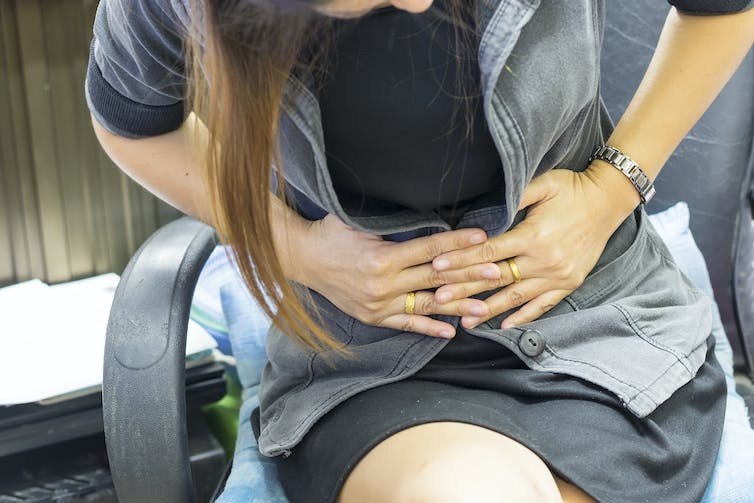
Chronic pelvic pain affects between 5% and 26% of women worldwide. It can be associated with conditions such as endometriosis (where tissue resembling the lining of the womb is found outside the womb) and interstitial cystitis (bladder pain syndrome). Some women also have chronic pelvic pain without a specific cause.
Despite how many women are affected by chronic pelvic pain, we still don’t fully understand the mechanisms underlying it. This has meant that women suffering from chronic pelvic pain have limited treatment options.
There are many reasons why the mechanisms causing chronic pelvic pain remain unknown. One of these is that there’s huge variation in the intensity and type of pain experienced – even in cases where the chronic pain is caused by a specific disease.
For example, some women with endometriosis experience no pelvic pain, others experience severe pain every day and others experience everything in between. The pain experienced also doesn’t correlate with what endometriosis looks like in the body.

This article is part of Women’s Health Matters, a series about the health and wellbeing of women and girls around the world. From menopause to miscarriage, pleasure to pain the articles in this series will delve into the full spectrum of women’s health issues to provide valuable information, insights and resources for women of all ages.
You may be interested in:
Vulva health conditions: it’s time to shatter the silence
Birth trauma is a growing problem — experiencing it myself revealed how few people understand it
UK’s first successful womb transplant – key questions answered
There are also many different types of pain experienced with chronic pelvic pain – including pain while menstruating, pain during sex and pain when urinating or having a bowel movement. People with chronic pelvic pain may experience any of these and in any combination.
We know from other chronic pain conditions (such as fibromyalgia and diabetic neuropathy) that different mechanisms cause pain depending on the person – and that each of these different mechanisms respond differently to treatments.
Research we conducted earlier this year has now shown that chronic pelvic pain operates similarly. Our research showed that the mechanisms that cause chronic pelvic pain seem to vary from person to person.
Mechanisms of pain
We conducted our study on 85 women – 59 of whom had chronic pelvic pain. Of those with chronic pelvic pain, 25 had endometriosis, 13 had bladder pain syndrome, 15 had both endometriosis and bladder pain syndrome and six had pain with no specific cause. Participants were from the UK, US and Portugal and were aged between 18 and 50.

Zetar Infinity/ Shutterstock
To understand whether the mechanism causing pelvic pain differed depending on the person, we carried out a series of sensory tests. This involved exposing the participants to various sensations – such as vibration, touch, pressure and temperature.
We also asked participants how these sensations felt to them, and at what point these sensations became painful. This allowed us to look at different types of nerves and how they function.
We also looked at how responses differed between those with chronic pelvic pain and those without pain. Participants were then grouped according to their sensory profiles.
One of the most striking findings was that women with chronic pelvic pain had lower pain thresholds when it came to sensations of pressure on the lower tummy and pelvis compared with the control group. This was particularly true in those with bladder pain. This suggests there’s communication between the pelvic organs and the skin, resulting in more pain.
We also found that some women with chronic pain were less able to detect changes in temperature and touch. This loss in nerve function suggests that for some, chronic pelvic pain may be caused by damage to the nerves.
We then looked at the overall sensory profiles of the chronic pelvic pain group to see which chronic pain subgroup they fitted into. We found that around 7% had a “healthy” sensory profile – meaning the way they felt the sensations were as we would expect from healthy people.
Around half of those with chronic pelvic pain were placed in the “mechanical hyperalgesia” subgroup. This meant they had changes in pain processing parts of the brain, which meant the volume of their pain was “turned up” by default.
Parallels of pain
This work gives new insight into the complexity of chronic pelvic pain in terms of the mechanisms causing it. It helps us draw parallels with other chronic pain conditions, which may mean we can use research and treatments that have worked for these conditions to pick new targets for treating chronic pelvic pain.
The next steps of this research will be working out what treatments will work for whom depending on their sensory pain profile and the underlying mechanisms causing their pain.
Treatments for chronic pelvic pain have limited effectiveness. For example, studies show 11-19% of women with endometriosis have no reduction in pain, even after surgery. Based on the findings of our study, a new approach could mean that specific treatments can be chosen instead for each person, depending on the mechanisms causing their pain. This would hopefully be more effective.
Given that chronic pelvic pain is so prevalent in women worldwide and has a huge effect on their quality of life and wellbeing, moving towards a more personalised approach to treatment could result in huge improvements for millions of women.
![]()
Lydia Coxon is affiliated with the Pelvic Pain Support Network.
This project has received funding from the Innovative Medicines Initiative 2 Joint Undertaking under grant agreement No (777500). This Joint Undertaking receives support from the European Union’s Horizon 2020 research and innovation programme and EFPIA.
Katy Vincent receives research funding from NIHR, UKRI, NIH, IMI-2, and Bayer AG. Her institution has received honoraria for consultancy she has done for Bayer AG, Eli Lilly, AbbVie and Reckitts.























